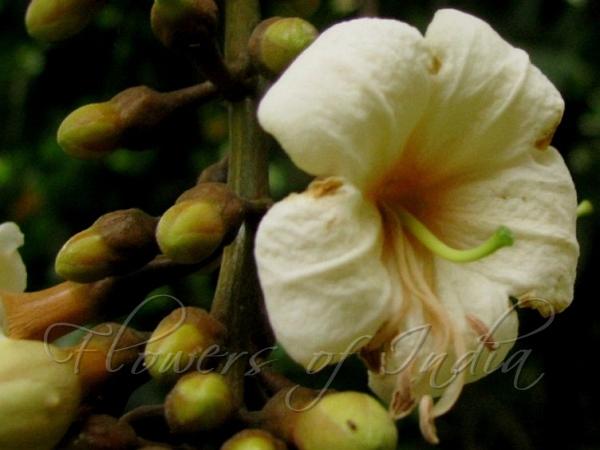|
| False Coffee Tree |
|

|

| File size | 59022 |
| Original date | 12/22/10 4:46 PM |
| Resolution | 752 x 564 |
| Flash | Flash did not fire, auto |
| Focal length | 6.0mm |
| Exposure time | 1/25s |
| Aperture | 2.7 |
| Focus Distance | |
| Metering Mode | Multi-segment |
| Camera make | Canon |
| Camera model | Canon PowerShot S5 IS |
| Sensor type | OneChipColorArea |
|
|
|
|
Photo: |
Botanical name: Fagraea racemosa Family: Gentianaceae (Gentian family)
Synonyms: Fagraea maingayi, Fagraea morindaefolia, Fagraea subreticulata
Synonyms: Fagraea maingayi, Fagraea morindaefolia, Fagraea subreticulata
False Coffee Tree is a shrub or small to medium-sized tree up to 25 m tall, bole up to 30 cm in diameter. The leaves are opposite, have stout stalks, and very leathery, oblong or ovate, 15-33 cm in length, 8-18 cm in width, rounded or somewhat heart-shaped at the base, and pointed at the tip. The stipules from a cup around the stem on which the leaves are borne. The flowers are borne in clusters on terminal inflorescences which are often 20-30 cm in length. They have a white, funnel-shaped corolla about 2.5 to 3 cm in diameter, with 5 prominent lobes. Fruit is round to ellipsoid-ovoid, apiculate, bluish or greenish or red when ripe, about 1 cm in diameter.
Medicinal uses: In the Philippines, the bark and the flowers
are used as an antidote for snakebite. A decoction of the roots is
frequently given as a tonic after fever, for pains in the loins, and for
coughs. A compound decoction of the leaves, with of santol (Sandoricum
koetjape), may be drunk as a tonic. The pounded roots are used for
poulticing an ulcerated nose. A decoction of the leaves may be used in a
medicinal bath for curing fevers in children. Boiled leaves are used for
dropsy. Leaves are used as a fomentation for rheumatism. The bark is
prescribed as an application for pains connected with miscarriage. The
root-bark is used as a febrifuge in India.
In the Philippines, the bark and the flowers
are used as an antidote for snakebite. A decoction of the roots is
frequently given as a tonic after fever, for pains in the loins, and for
coughs. A compound decoction of the leaves, with of santol (Sandoricum
koetjape), may be drunk as a tonic. The pounded roots are used for
poulticing an ulcerated nose. A decoction of the leaves may be used in a
medicinal bath for curing fevers in children. Boiled leaves are used for
dropsy. Leaves are used as a fomentation for rheumatism. The bark is
prescribed as an application for pains connected with miscarriage. The
root-bark is used as a febrifuge in India.
Medicinal uses:
 In the Philippines, the bark and the flowers
are used as an antidote for snakebite. A decoction of the roots is
frequently given as a tonic after fever, for pains in the loins, and for
coughs. A compound decoction of the leaves, with of santol (Sandoricum
koetjape), may be drunk as a tonic. The pounded roots are used for
poulticing an ulcerated nose. A decoction of the leaves may be used in a
medicinal bath for curing fevers in children. Boiled leaves are used for
dropsy. Leaves are used as a fomentation for rheumatism. The bark is
prescribed as an application for pains connected with miscarriage. The
root-bark is used as a febrifuge in India.
In the Philippines, the bark and the flowers
are used as an antidote for snakebite. A decoction of the roots is
frequently given as a tonic after fever, for pains in the loins, and for
coughs. A compound decoction of the leaves, with of santol (Sandoricum
koetjape), may be drunk as a tonic. The pounded roots are used for
poulticing an ulcerated nose. A decoction of the leaves may be used in a
medicinal bath for curing fevers in children. Boiled leaves are used for
dropsy. Leaves are used as a fomentation for rheumatism. The bark is
prescribed as an application for pains connected with miscarriage. The
root-bark is used as a febrifuge in India.
Identification credit: Prashant Awale, K. Karthigeyan
| Photographed at Jirkatang, Andaman & Nicobar. |